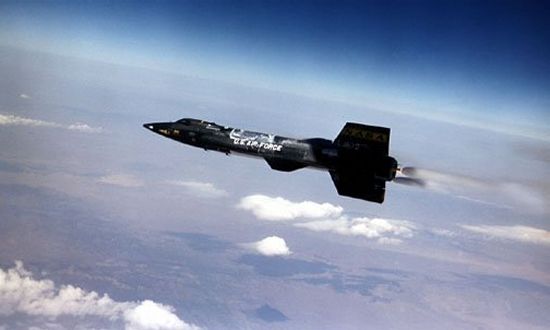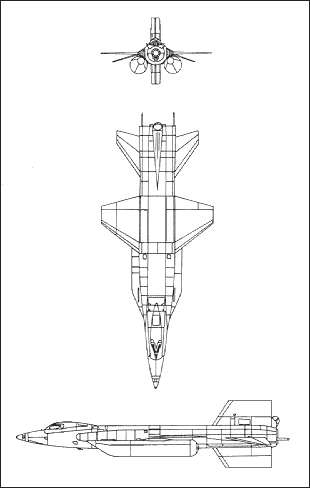|
||||||||||
|
|
||||||||||
|
||||||||||
|
|
||||||||||
 - -
|
|

|
North American X-15 High-Speed Research Aircraft |
|
DESCRIPTION:
The X-15 remains the fastest and highest flying manned aircraft ever flown, and is regarded by many as the most important research plane in history. The X-15 emerged from a combined US Air Force and US Navy request for a research aircraft to reach altitudes of 250,000 ft and speeds exceeding Mach 6. The design featured a long slender fuselage with fairings along the side containing fuel and early computerized control systems. Thick fins were placed on the aft fuselage to provide directional control, and the bottom fin was ejected shortly before landing to provide clearance for the landing skids. The X-15 was carried aloft by a modified B-52 bomber before its rocket engine powered it to the very edge of the atmosphere. The improved X-15A-2 was extensively modified with heat-resistant coatings and large external fuel tanks so that it could fly even higher and faster than earlier examples. Though the Air Force and Navy funded the project, NACA, later NASA, was in charge of the flight test program. Despite some early accidents, nearly 200 flights were made between 1959 and 1968 allowing NASA to collect data vital to the design of the Space Shuttle.
Data below for X-15A |
|
| HISTORY: | |
|
First Flight
|
(X-15A) 10 March 1959 [carried by B-52 but not released] (X-15A) 8 June 1959 [unpowered glide] (X-15A) 17 September 1959 [powered flight] (X-15A-2) 28 June 1964 |
| CREW: |
one: pilot
|
|
ESTIMATED COST:
|
unknown
|
| AIRFOIL SECTIONS: | |
| Wing Root | unknown |
|
Wing Tip
|
unknown
|
| DIMENSIONS: | |
| Length | 50.00 ft (15.24 m) |
| Wingspan | 22.00 ft (6.71 m) |
| Height | 13.50 ft (4.12 m) |
| Wing Area | 200 ft² (18.58 m²) |
|
Canard Area
|
not applicable
|
| WEIGHTS: | |
| Empty | 13,000 lb (5,895 kg) |
| Normal Takeoff | unknown |
| Max Takeoff | 34,000 lb (15,420 kg) |
| Fuel Capacity |
internal: unknown external: unknown |
|
Max Payload
|
unknown
|
| PROPULSION: | |
| Powerplant | one Reaction Motors XLR-99 rocket motor |
| Thrust |
57,000 lb (253.6 kN) at sea level 70,000 lb (311.4 kN) at peak altitude |
| PERFORMANCE: | |
| Max Level Speed |
(X-15A) 4,160 mph (6,695 km/h) (X-15A-2) 4,520 mph (7,274 km/h) at 102,100 ft (31,120 m), Mach 6.72 |
| Initial Climb Rate | unknown |
| Service Ceiling | (X-15A-2) 354,200 ft (107,960 m) |
| Range | 215 nm (400 km) |
| g-Limits |
unknown
|
| KNOWN VARIANTS: | |
| X-15A | Original design first powered by an 8,000 lb (35.6 kN) thrust XLR-11 rocket engine; 3 built |
| X-15A-2 |
Second X-15A rebuilt following a landing accident, featured a longer fuselage, external fuel tanks, and
heat-resistant surface; 1 converted
|
|
KNOWN OPERATORS:
|
United States (US Air Force) United States (NASA) |
|
3-VIEW SCHEMATIC:

|
|
SOURCES:
|
|


|
Aircraft | Design | Ask Us | Shop | Search |

|
|
| About Us | Contact Us | Copyright © 1997-2023 | |||
|
|
|||